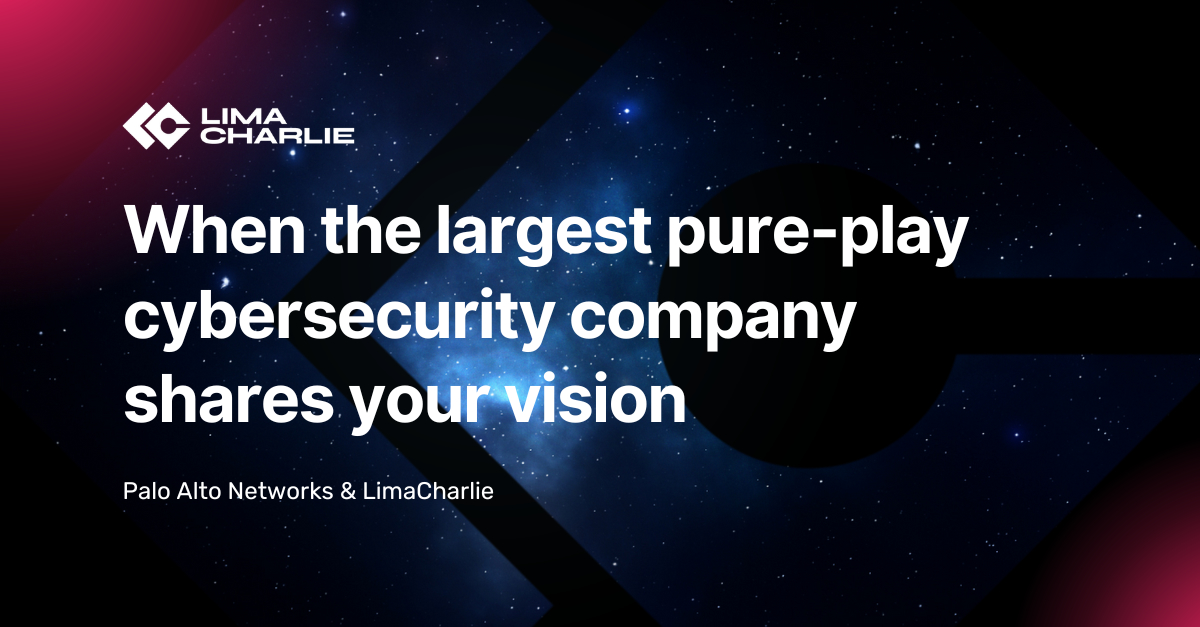When the largest pure-play cybersecurity company shares your vision: Palo Alto Networks and LimaCharlie

CEO and Founder

When we put forward a vision for cybersecurity talking about building one platform that covers all security operations - or as we call it SecOps Cloud Platform - we could not have imagined that a month later, the world’s largest pure-play cybersecurity company would buy into this vision. This alignment is flattering, to say the least.
Yesterday, Cole Grolmus of Strategy of Security published an article titled The Audacious Future of Palo Alto Networks. I would highly recommend this piece to anyone interested in the future of cybersecurity - not to learn about Palo Alto Networks (PANW) but to see what the future of security looks like.
For any startup with a large vision, the hardest part often isn’t to build the future but to get others to listen. The signal-to-noise ratio in the industry is so low, that getting people to pause and think is much easier when some of the message comes from one of the currently largest vendors. For us at LimaCharlie, what matters isn’t whom people listen to, but where the industry is going. And, if Palo Alto Networks is moving in a similar direction (and so it seems to me), that’s a win for everyone.
Where our visions are aligned
It appears that both Palo Alto Networks & LimaCharlie share the same idea that security teams rely on disjoint tools and stitch together tens and hundreds of solutions to solve their problems. A different approach is needed - one that enables them to access the security capabilities they need in one place.
Where our views differ
Although we see a similar path for the future, we differ vastly in how we believe we should be getting there as an industry.
Salesforce vs AWS for security
Nikesh Arora suggests that “...in the next decade, we will see sort of a standard platform for security out there, just the way we've seen platforms in CRM or we've seen platforms in HR, as you've seen platforms and financial sort of software.”
Although we agree that a single platform is needed, we don’t believe it will take the form of a CRM - a monolithic platform where users need to negotiate long-term contracts, buy separate modules, and buy packages of solutions. Instead, we envision an AWS-like solution where users can easily try the solution before talking to salespeople, scale up/scale down as needed, and own their destiny. Unlike CRMs built to be an all-in-one solution, AWS-like approach to security means that users can leverage API-first architecture, and build the security stack they need.
Acquiring vs building in-house
When we set out to build LimaCharlie, we spent a lot of time thinking about ways in which the innovation in the industry is going to develop. One of the realizations was that the security platform of the future both PANW and LimaCharlie want to see needs to be built to work together from the ground up. AWS is what it is - scalable, API-first, engineering-driven precisely because it was architected that way and built from the ground up. If a large data management vendor acquired a networking company, a storage startup, and an orchestration solution, and integrated them all together, we would get a platform, but we wouldn’t get an AWS.
We agree with Nikesh’s take that the industry needs real-time security. As an engineer, I know that it’s hard to accomplish real-time outcomes if the solutions that need to talk to one another were not built as such from day one. That is yet another reason we think LimaCharlie’s approach offers a better way.
Changing the way products are bought and sold
We cannot transform the industry unless we change the way security products are purchased. If we want to mature the security space, we need to move away from restrictive software licensing and give security practitioners the ability to try tooling before they buy.
Doing this is much harder when the machine that made the company successful to begin with isn’t aligned with this new way of doing things. Is it possible for the market leader to change? Certainly. The hard part is going to be to navigate the incentive structure and systems that have existed for a long time.
Going into the future
Having Palo Alto Networks aligned with our view of the world is certainly going to make the journey much more fun. Can a startup win against the established market leader? We think the answer is a loud and clear yes. PANW is a huge ship with dozens of divisions that are going to be fighting together for who gets to do what to make this vision a reality. Maybe they’ll make it but I think they have a harder job ahead of them than we do.
Such is the nature of the innovator’s dilemma. This is how we win.